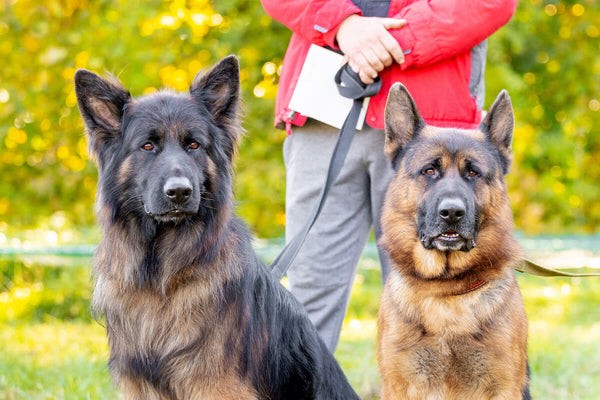
The King Shepherd and German Shepherd, while sharing common ancestry, represent distinct breeds with unique characteristics. The German Shepherd, developed in late 19th century Germany, has established itself as a versatile working dog. In contrast, the King Shepherd, bred in the 1990s United States, emerged as a larger, potentially healthier variant. While both breeds exhibit similar temperaments and intelligence, they differ notably in size, coat characteristics, and health predispositions. This report examines these distinctions to provide potential owners with crucial insights for making an informed choice between these magnificent shepherd breeds.
King Shepherd vs German Shepherd: Distinctive Traits and Comparisons
Physical & Dimensional Contrasts
While German Shepherds are already considered large dogs, King Shepherds are notably larger, standing 25-31 inches tall and weighing 90-150 pounds compared to German Shepherds at 22-26 inches and 50-90 pounds. King Shepherds have a wider, more square frame without the sloping back often seen in German Shepherds. Their coat is typically longer and thicker due to their mixed ancestry with breeds like Alaskan Malamutes. This results in more intensive grooming needs with daily brushing recommended to manage shedding.
Cost & Availability Differences
An interesting contrast lies in the pricing and accessibility of these breeds. King Shepherds are generally more affordable, with prices ranging from $1,250-$3,500, while purebred German Shepherds can cost upwards of $5,000. However, King Shepherds are significantly rarer, which can lead to longer wait times for puppies. As a newer hybrid breed not recognized by the AKC, finding reputable King Shepherd breeders requires more research compared to the well-established German Shepherd breeding programs. The cost difference stems primarily from the King Shepherd's hybrid status versus the German Shepherd's purebred pedigree.
Physical Differences & Temperament Comparison Between King and German Shepherds
Physical Structure & Movement
While the previous section covered basic dimensional differences, there are notable distinctions in build and mobility. King Shepherds have a more balanced stance with a straighter topline compared to German Shepherds' sloped back. This structural difference results in smoother movement patterns and potentially fewer hip problems in King Shepherds. Their bone structure is also more robust, with a broader chest and thicker limbs, contributing to their overall sturdier appearance.
Energy & Personality Traits
Though both breeds share high intelligence, King Shepherds display a more laid-back temperament compared to the high-drive German Shepherd. German Shepherds require more intense daily exercise and mental stimulation, while King Shepherds exhibit moderate energy levels. This temperamental difference stems from their breeding purpose - German Shepherds were bred specifically for work and herding, whereas King Shepherds were developed with companion qualities in mind. King Shepherds tend to be less reactive and show more patience in family settings, though they maintain strong protective instincts. They typically display less prey drive and territorial behavior compared to German Shepherds, making them more adaptable to multi-pet households.
King Shepherd vs German Shepherd: Health & Breeding Distinctions
Genetic Health Profile
While both breeds can inherit similar conditions, King Shepherds were specifically bred to have fewer health issues compared to German Shepherds. This genetic diversity from crossbreeding has resulted in King Shepherds having longer average lifespans of 10-11 years versus 7-10 years for German Shepherds. However, due to their significant German Shepherd ancestry, King Shepherds still face risks of inherited conditions like hip dysplasia and von Willebrand's disease, though at lower rates.
Breeding Philosophy & Recognition
The breeding approaches for these dogs reflect different historical priorities. King Shepherds emerged in the 1990s through selective crossbreeding aimed at creating a healthier, larger alternative to German Shepherds. While German Shepherds were bred purely for working capabilities in the early 1900s, King Shepherds were developed with both companionship and health in mind. This fundamental difference in breeding philosophy impacts their recognition status - German Shepherds are AKC-recognized purebreds, while King Shepherds are certified by smaller organizations like the American Rare Breed Association. Unlike German Shepherds' standardized breeding programs, King Shepherd breeding involves carefully selected crosses with breeds like Alaskan Malamutes and Great Pyrenees to maintain desired traits while maximizing genetic health benefits.
Conclusion
The comparison between King Shepherds and German Shepherds reveals several key distinctions between these breeds. King Shepherds are notably larger in size, with a straighter back and sturdier build compared to German Shepherds. While typically more affordable, King Shepherds are rarer and less readily available. They also demonstrate a more laid-back temperament compared to the high-drive German Shepherd, making them potentially better suited for family settings.
Perhaps most significantly, King Shepherds were specifically bred to address health concerns common in German Shepherds, resulting in a longer average lifespan and lower rates of inherited conditions. This intentional breeding philosophy, focused on both health and companionship rather than purely working abilities, has produced a dog that maintains the beloved characteristics of German Shepherds while potentially offering improved health outcomes. For potential owners, the choice between these breeds may come down to balancing factors such as availability, exercise needs, and intended use, with King Shepherds generally being better suited as family companions and German Shepherds excelling in working roles.